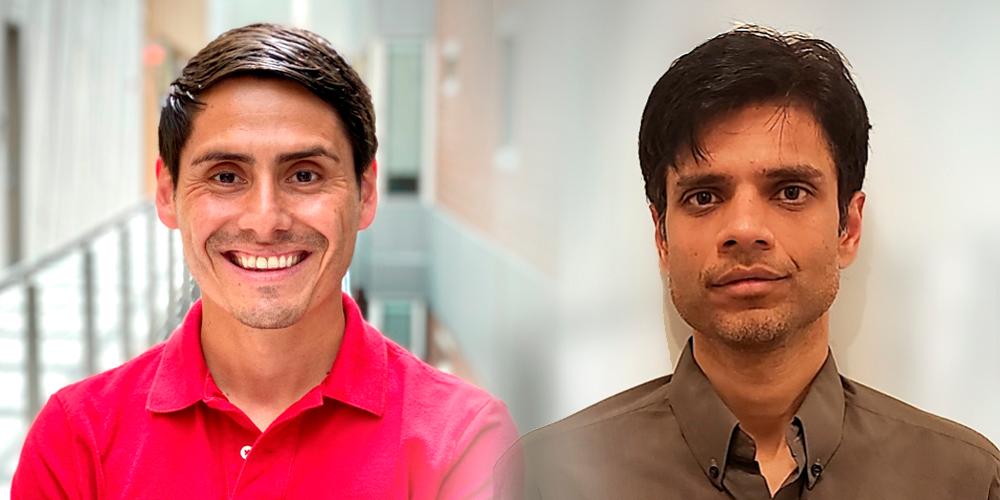
Glaucoma affects 3 million Americans, is incurable, and is the second leading cause of blindness worldwide. Even with the disease’s prevalence, how and why it develops is still largely not understood.
Samuel Herberg, PhD, is an assistant professor of ophthalmology & visual sciences, as well as a researcher at Upstate’s Center for Vision Research, is working to create new ways to study the cells and structures in the eye that can help better understand glaucoma. He was recently awarded $439k from the National Eye Institute (NEI) over two years to develop a unique 3D model to study specific mechanisms of fluid outflow and pressure regulation in the eye.
The project will use the engineering expertise of Syracuse University bioengineer Pranav Soman, PhD.
This project focuses on understanding how the eye maintains normal pressure through the drainage of fluid called aqueous humor. The outflow system involves key structures such as the trabecular meshwork (TM) and Schlemm’s canal (SC). It is known that the rigidity or stiffness of the TM in different areas affects how well fluid flows, with stiffer areas allowing less fluid to pass.
“When this drainage system doesn’t work properly, it can lead to high pressure in the eye,” explains Herberg. “This can damage vision.”
It still isn’t fully understood why some areas of the outflow system are stiffer than others and how this contributes to high pressure. One reason for this knowledge gap? Current models of the drainage system don’t accurately mimic real-life conditions.
This project aims to create a new model called a “TM/SC-interface-on-a-chip” that better mimics the real drainage system. This model will allow researchers to study how different parts of the drainage system contribute to fluid flow and pressure regulation more accurately. By manipulating specific components of the drainage system, researchers hope to uncover the mechanisms behind pressure regulation in the eye more precisely. To validate the new experimental model, Herberg enlisted the help of Weiming Mao, MD, PhD at Indiana University School of Medicine, whose human corneal rim perfusion model will serve as a benchmark.
“The contributions of these relatively low and high flow areas are not clear,” says Herberg, “There’s evidence that areas that have previously been high flow may lose that ability and become more of a low flow area, possibly causing the neighboring areas to be also less efficient. Over many decades, this could add up to a larger vision problem.”
Herberg hopes this 3D model will help bridge the gap between conventional 2D assays for drug screening and animal or human trials. “Using these three-dimensional constructs more physiologically close to the tissue can fill a niche.”
Working with others at the Bio-Inspired Institute, a collaboration of experts in life sciences, engineering, physics, and chemistry from Upstate, Syracuse University, and SUNY ESF, has been a large part of Herberg’s research.
“I take full advantage of my colleagues; I quickly identified [Dr. Soman] as somebody who has tools that might come in handy.”
Soman has been working to use new technology to achieve something seemingly simple; to recreate nature’s ability to arrange a few materials (proteins, sugars, minerals) into complex structures optimized to satisfy specific environmental demands.
“Man-made manufacturing, however, is unable to match nature’s building capabilities,” says Soman. “Using my background in mechanical engineering, optics, biomaterials and cell biology, my group’s goal is to close this gap between nature and man-made manufacturing capabilities by developing new machines (3D printers) and processing technologies.”
Soman will be using his 3D-printed master molds to develop models that can provide “an advanced yet accessible platform for high-throughput screening of new glaucoma drug or cell-therapy candidates.”
Creating these types of structures for researchers to study cells and mechanisms has grown into an entire industry for Soman; he founded a startup called 3DMicrofluidics LLC (3DM) to provide precision microparts to customers who do not have access to exclusive and expensive micro/nano-fabrication cleanroom facilities.
You can read more about Herberg’s lab and work here.
For more on the BioInspired Institute, visit their site at https://bioinspired.syr.edu/
–Kayla Richmond
